2-day-old neonatal patient with rash
A 2-day-old neonate was taken to his provider for evaluation of a rash that was just noticed. He has had no fever and his appetite has been vigorous and behavior has not changed. He was taken home from couplet care the day before with a normal exam, and no other concerns were noted. His prenatal history was uncomplicated except that the mother has occasional “cold sores.” She had no problems noted during pregnancy, labor or delivery, including no genital herpes noticed. Because of the rash and the mother’s history of cold sores, the baby was admitted for evaluation.
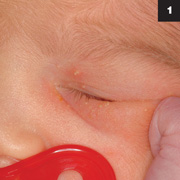 | 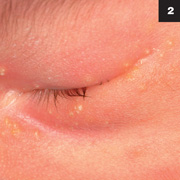 |
The rash consisted of several small pustular lesions located about the left eye. All photos courtesy of James H. Brien. | |
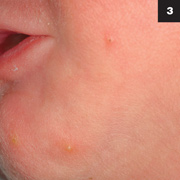 | 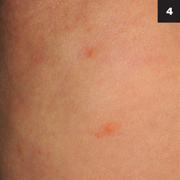 |
The patient also had several scattered lesions on the chin and trunk. | |
Examination upon arrival revealed an alert, active baby with normal vital signs and a rash that consisted of several small pustular lesions with minimal to no erythema at the bases, located about the left eye (figures 1 & 2), and several scattered lesions on the chin and trunk (figures 3, & 4). The rest of his exam was normal for his age.
Lab test obtained upon admission included a herpes virus culture and PCR of material from a couple of the lesions, and high-dose acyclovir (60-mg/kg/day) was started.
What’s Your Diagnosis?
- Neonatal herpes
- Staph pustulosis
- Neonatal candidiasis
- Erythema toxicum
Case Discussion
This is a case of erythema toxicum (D); a common, non-infectious dermatologic condition of newborns. The lesions are described as benign papulo-pustular lesions on various-sized erythematous bases, usually appearing during the first week of life. They can appear anywhere, but are more common on the trunk. If the contents of a lesion is stained (H&E), one is likely to see eosinophils; Gram stain will reveal no organisms and culture will be negative. They require no therapy; only reassurance that they will resolve over a period of days to weeks.
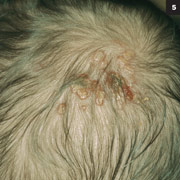 | 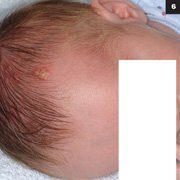 |
If the rash was herpes, the lesions would
likely to be somewhat larger and in coalescing clusters, as shown in figures 5 and 6 above. | |
In most medical center settings, a PCR can be used to rapidly rule out herpes simplex virus (HSV). If PCR is not available, one can usually distinguish the difference on the following clinical grounds: (1) Herpes lesions typically appear a bit later, usually 5 to 10 days of age, (2) the lesions are likely to be somewhat larger and in coalescing clusters, as shown in figures 5 & 6, (3) the baby may have a fever and/or may not be acting well, (4) the history may reveal maternal HSV infection, particularly a primary infection around the time of delivery. However, many cases of neonatal HSV infection occur without the exposure history, and there can be much overlap in the appearance of the lesion, therefore caution is always advised until HSV can be ruled out. If a neonate is suspected of having an HSV infection, a full sepsis workup should be done and treatment with high-dose acyclovir begun pending confirmation of the diagnosis. The duration of therapy is dictated by the category of the infection (skin-eye-mouth vs. disseminated vs. CNS). See the 2009 Red Book for details.
Staph pustulosis has become a fairly uncommon infection in newborns, but may initially present with very similar-appearing lesions. However, they are likely to grow in size and become “angrier” as they enlarge, with more erythema, and if one performs a Gram stain on the contents, Gram-positive cocci should be seen. These patients are best treated in a hospital setting until there is clear improvement and the organism recovered with sensitivities.
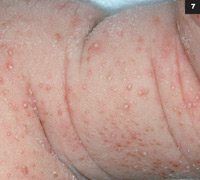 |
A patient with neonatal
candidiasis. |
Lastly, neonatal candidiasis is also an uncommon pustular condition of the newborn due to Candida albicans. There may be only a few lesions or there may be hundreds (figure 7). It occurs as a result of exposure and colonization during birth. Mild infections may need no treatment or oral fluconazole, whereas some with widespread cutaneous disease and/or evidence of visceral dissemination, particularly to the lungs, one may need to use more aggressive anti-fungal therapy with Amphotericin B.
This is the first in a brief series of skin conditions seen in infants, which can often be difficult to diagnose in a timely fashion. Some, like erythema toxicum, are fairly harmless, whereas others may have devastating consequences. Stay tuned.
Columnist comments
In the April 2009 column, I mentioned the experience of my old friend and fellow retired military pediatrician (Navy), Dr. Itzhak Brook, who had been diagnosed with hypopharyngeal cancer. Since then, Dr. Brook has campaigned for the enlightenment of physicians and other health care professionals to see disease through the eyes of the patient in hopes of making us more aware and sensitive to the fear and anxiety they usually experience. He has now published a book about his experience, My Voice — A Physician’s Personal Experience With Throat Cancer, describing the three years after his diagnosis from the perspective of a physician with decades of patient care experience. He addresses medical errors, prolonged hospitalizations with multiple surgical procedures, the discrimination after the loss of his voice and the struggle to regain it. In an age of increased demand for patient safety and quality, Dr. Brook can probably teach us all something about these issues. The introduction and first chapter of the book is available on Dr. Brook’s blog at: http://dribrook.blogspot.com/, and he plans to post additional chapters every week.
For those who are interested in having a printed copy of the book, it can be obtained at www.createspace.com/900004368.

Vice Chair for Education at The Children’s Hospital at Scott
and White and Associate Professor of Pediatrics at Texas A&M University,
College of Medicine, Temple, Texas. E-mail: jhbrien@aol.com.
e-mail:jhbrien@aol.com
As a prolific researcher and writer, Dr. Brook has published many papers, books and book chapters. So I would not have expected less with regard to his experience as a patient with a life-threatening illness. It seems a bit ironic that in addition to anaerobic infections, one of his main areas of interests is in infections of the head, neck and sinuses. In fact, around the time he was being diagnosed, his book, Diagnosis and Management of Pediatric Sinusitis, was published; a handy, pocket-sized manual of management of sinus disease in children. In fact, you can review it in its entirety on Google. Dr. Brook has contributed significantly to our knowledge of infectious diseases, and I’m glad he is still able to teach us how to be better physicians.
